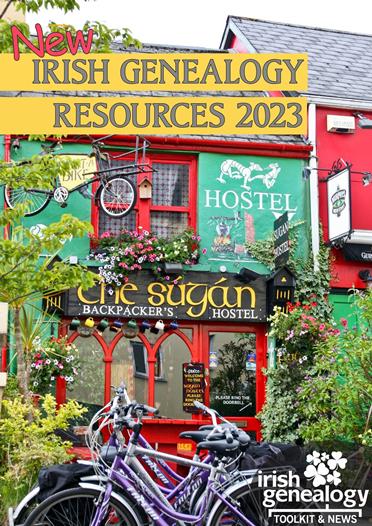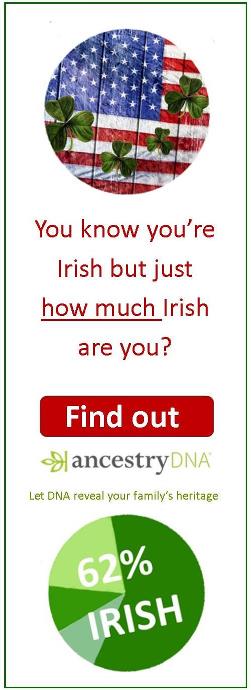- Home ›
- Civil Registration, overview ›
- IrishGenealogy.ie Tips
Tips for searching IrishGenealogy.ie
Civil Records
Before you start searching the IrishGenealogy.ie database, it's worth finding out what the database holds and how it is works. A few minutes of background research may save you hours of frustrating and unrewarding research.
IrishGenealogy.ie basics
The IrishGenealogy.ie database is run by the state and updated on an annual basis.
For data-protection reasons, it publishes historical records according to the widely accepted 100-75-50-years rule, viz:
IrishGenealogy.ie's civil records database contains records from across the island (all 32 counties) up to and including 1921. From 1922 it holds records from the 26 counties of the Republic of Ireland only.
- Birth records over 100 years old
- Marriage records over 75 years old
- Death records over 50 years old.
IrishGenealogy.ie's civil records database contains records from across the island (all 32 counties) up to and including 1921. From 1922 it holds records from the 26 counties of the Republic of Ireland only.
All records are free to search. Where available, images are linked from the Index and are downloaded in pdf format to your computer. You can then save/print them.
The images take in a full page of the register, so you will usually find unrelated entries adjacent to the one you wanted to see.
At January 2020, you can search:
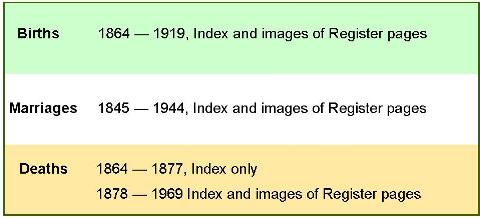
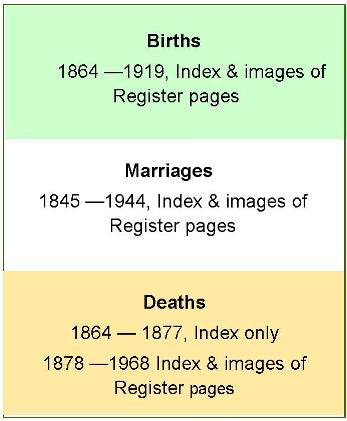
Accessing the database
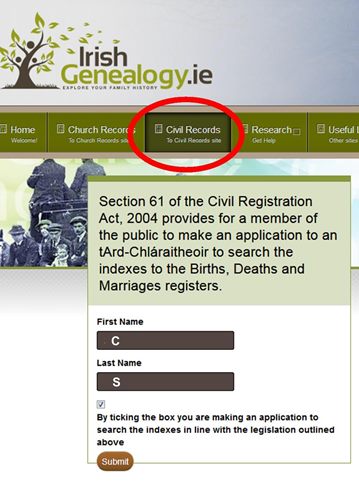
You can access the database by either going to IrishGenealogy.ie and clicking the Civil Records tab or using this direct link to the Civil Records database.
You then fill in the boxes with details of the record you are seeking. You don't have to fill in all the fields.
You will be asked to fill in a Captcha.
An official looking pop-up then appears, quoting Section 61 of the Civil Registration Act, 2004, and requiring you 'to make an application' to search the records. You can type anything you like into the name boxes.
You can type your own name, a made up name, your initials, anything. It makes no difference. No data is being collected!
As you can see from the image, above, I generally use my initials, or just press random letters on my keyboard.
Click the tick box and you'll find your results. At this point you can add details or filter your results.
You can access the database by either going to IrishGenealogy.ie and clicking the Civil Records tab or using this direct link to the Civil Records database.
You then fill in the boxes with details of the record you are seeking. You don't have to fill in all the fields.
You will be asked to fill in a Captcha.

Click the tick box and you'll find your results. At this point you can add details or filter your results.
Tips for searching IrishGenealogy.ie
- Only a first name is indexed. If you search for a 'John Patrick', for example, you will get a nil return. Unfortunately, the same is true even for traditional two-part names such as Mary Ann and Mary Jane. You need to use only the first name.
- Mothers' surnames are included in the Birth Index from 1900.
- If you search the Birth Index for a family name with no first name, post-1900 results will include all children born with a father OR mother of that surname.
- If you are searching the post-1900 Birth Index for all the children in a family, leave the first name field blank. In the surname field, type both the mother's and father's surnames, separated by a space. This cannot be done for pre-1900 births because mothers' surnames have not been indexed.
- Infants born in hospitals were usually registered by a hospital official, typically the day after the birth. Often, the parents had yet to decide on a first name, or had not told the official what the name would be, so the baby was registered without a first name in the Register. These cases appear in the Birth Index as 'Unknown' + surname.
- If you don't know the maiden name of a married women, nor the first name of her husband, you can use the Marriage Index to discover not only her birth surname but also her husband's first name. Search using her first name and married surname, entering an approximate date for the marriage.
- Be sure to check details of the informant on a death registration. The informant is usually a family member and his/her address and relationship to the deceased will be noted. These details may confirm that the death record is the one you are seeking; they may also give you additional genealogical information to follow up.
- One of the worst problems when using any family history database is the possibility that your ancestor's name has been spelt differently to how you spell it. Irish first names and surnames are notorious for this, so you have to be pretty persistent and sometimes quite imaginative to track down records when they are not showing up where you expect them to show up. See the Name Spellings problems box for some help.
- If you cannot find an entry in IrishGenealogy's Index but you are confident of the location and have some idea of the year in which the event took place, you will need to open a 'back door' to the local SRD's registers and browse through them. The process is a little fiddly, and may vary slightly according to which browser you use, but it can yield results. First, enter your search criteria - the SRD and relevant years - and choose which Index you want. On the results page, choose any entry and hover over the word 'image', right click and select 'copy link location' from the menu. Paste this into your browser. By changing the very last digit, you can 'browse' back and forward through all the pages in the register. (Don't forget that the records were maintained on a quarterly basis from 1878 to 1902; you'll need to go through this process four times for each of these years.)
Civil records: references and IDs
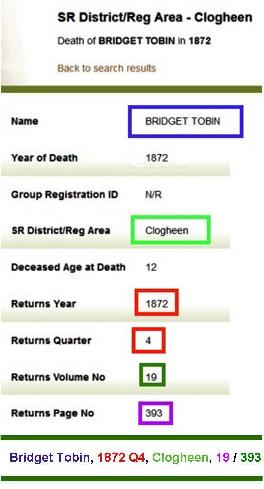
All the Indexed entries with attached images have a Group Registration ID or GRID number. This is a unique reference for the register entry.
Those Indexed entries without attached images (Marriages 1845-1863 and Deaths 1864-1877) do not have a GRID no. Instead, you have to create a reference from the Indexed details.
The usual format is Name, Year & Quarter, SRD/Registration District, Volume No. and Page No. This reference identifies the exact entry in the Registers.
In the example right, the Index Reference is Bridget Tobin, 1872 Q4, Clogheen, 19/393.
Only a first name is indexed. If you search for a 'John Patrick', for example, you will get a nil return. Unfortunately, the same is true even for traditional two-part names such as Mary Ann and Mary Jane. You need to use only the first name.
Mothers' surnames are included in the Birth Index from 1900.
If you search the Birth Index for a family name with no first name, post-1900 results will include all children born with a father OR mother of that surname.
If you are searching the post-1900 Birth Index for all the children in a family, leave the first name field blank. In the surname field, type both the mother's and father's surnames, separated by a space. This cannot be done for pre-1900 births because mothers' surnames have not been indexed.
Infants born in hospitals were usually registered by a hospital official, typically the day after the birth. Often, the parents had yet to decide on a first name, or had not told the official what the name would be, so the baby was registered without a first name in the Register. These cases appear in the Birth Index as 'Unknown' + surname.
The (re-) marriage of a widow is usually recorded in the Index under the woman's maiden name. The image of the register entry will show all former names.
If you don't know the maiden name of a married women, nor the first name of her husband, you can use the Marriage Index to discover not only her birth surname but also her husband's first name. Search using her first name and married surname, entering an approximate date for the marriage.
Be sure to check details of the informant on a death registration. The informant is usually a family member and his/her address and relationship to the deceased will be noted. These details may confirm that the death record is the one you are seeking; they may also give you additional genealogical information to follow up.
One of the worst problems when using any family history database is the possibility that your ancestor's name has been spelt differently to how you spell it. Irish first names and surnames are notorious for this, so you have to be pretty persistent and sometimes quite imaginative to track down records when they are not showing up where you expect them to show up. See the Name Spellings problems box for some help.
If you cannot find an entry in IrishGenealogy's Index but you are confident of the location and have some idea of the year in which the event took place, you will need to open a 'back door' to the local SRD's registers and browse through them. The process is a little fiddly, and may vary slightly according to which browser you use, but it can yield results. First, enter your search criteria - the SRD and relevant years - and choose which Index you want. On the results page, choose any entry and hover over the word 'image', right click and select 'copy link location' from the menu. Paste this into your browser. By changing the very last digit, you can 'browse' back and forward through all the pages in the register. (Don't forget that the records were maintained on a quarterly basis from 1878 to 1902; you'll need to go through this process four times for each of these years.)
Civil Records:
References and IDs
All the Indexed entries with attached images have a Group Registration ID or GRID number. This is a unique reference for the register entry.
Those Indexed entries without attached images (Marriages 1845-1863 and Deaths 1864-1877) do not have a GRID no. Instead, you have to create a reference from the Indexed details. The usual format is Name, Year & Quarter, SRD/Registration District, Volume No. and Page No. This reference identifies the exact entry in the Registers.
In the example below, the Index Reference is Bridget Tobin, 1872 Q4, Clogheen, 19/393.

Name spelling problems
Always remember that the Index is created from the name 'as written' on the register entry. There may have been a mis-spelling, the O or Mc prefix may have been added or removed, or the official filling in the form may simply have had his own idiosyncratic way of spelling a particular name... this is how the birth, marriage or death record will have been indexed. Unfortunately, IrishGenealogy's search facility is not wonderful at recognizing name variants. It is, however, much better than it used to be!
These days, if, for example, you search for a McDonagh, you will receive results for McDonagh, McDonaough, McDonaugh, McDonogh, McDona, MacDonagh and Mc Donagh. But not M'Donagh. Similar problems arise with the O prefix. The only solution is to do multiple searches using all the variant spellings you can think of for a name; a pattern should soon emerge.
Alternatively, use a different Index. FamilySearch.org's index is my preferred alternative, and it performs well with variant names. Find an indexed entry of interest, note the spelling and the Index Reference. Then return to IrishGenealogy.ie to find an image of the Register entry (if it's available).

